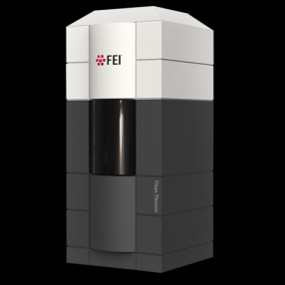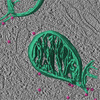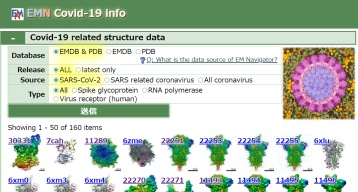[English] 日本語
 Yorodumi
Yorodumi- EMDB-18194: Cryo-electron tomogram of GEM2-labelled Mito-EGFP in HeLa cells -
+ Open data
Open data
- Basic information
Basic information
| Entry |  | |||||||||||||||||||||
|---|---|---|---|---|---|---|---|---|---|---|---|---|---|---|---|---|---|---|---|---|---|---|
| Title | Cryo-electron tomogram of GEM2-labelled Mito-EGFP in HeLa cells | |||||||||||||||||||||
 Map data Map data | Unfiltered tomogram corresponding to tilt series TS_010.mrc of Dataset 2 (220330) of EMPIAR-11561 | |||||||||||||||||||||
 Sample Sample |
| |||||||||||||||||||||
 Keywords Keywords | Encapsulin / Protein Engineering / Synechococcus elongatus Srp1 / intracellular labeling of mitochondrial-targeted EGFP / CYTOSOLIC PROTEIN | |||||||||||||||||||||
| Biological species |  Synechococcus elongatus PCC 7942 = FACHB-805 (bacteria) Synechococcus elongatus PCC 7942 = FACHB-805 (bacteria) | |||||||||||||||||||||
| Method | electron tomography / cryo EM / Resolution: 13.7 Å | |||||||||||||||||||||
 Authors Authors | Fung HKH / Hayashi Y / Salo VT / Babenko A / Zagoriy I / Brunner A / Ellenberg J / Mueller CW / Cuylen-Haering S / Mahamid J | |||||||||||||||||||||
| Funding support |  Germany, European Union, Germany, European Union,  France, France,  Finland, 6 items Finland, 6 items
| |||||||||||||||||||||
 Citation Citation |  Journal: Nat Methods / Year: 2023 Journal: Nat Methods / Year: 2023Title: Genetically encoded multimeric tags for subcellular protein localization in cryo-EM. Authors: Herman K H Fung / Yuki Hayashi / Veijo T Salo / Anastasiia Babenko / Ievgeniia Zagoriy / Andreas Brunner / Jan Ellenberg / Christoph W Müller / Sara Cuylen-Haering / Julia Mahamid /  Abstract: Cryo-electron tomography (cryo-ET) allows for label-free high-resolution imaging of macromolecular assemblies in their native cellular context. However, the localization of macromolecules of interest ...Cryo-electron tomography (cryo-ET) allows for label-free high-resolution imaging of macromolecular assemblies in their native cellular context. However, the localization of macromolecules of interest in tomographic volumes can be challenging. Here we present a ligand-inducible labeling strategy for intracellular proteins based on fluorescent, 25-nm-sized, genetically encoded multimeric particles (GEMs). The particles exhibit recognizable structural signatures, enabling their automated detection in cryo-ET data by convolutional neural networks. The coupling of GEMs to green fluorescent protein-tagged macromolecules of interest is triggered by addition of a small-molecule ligand, allowing for time-controlled labeling to minimize disturbance to native protein function. We demonstrate the applicability of GEMs for subcellular-level localization of endogenous and overexpressed proteins across different organelles in human cells using cryo-correlative fluorescence and cryo-ET imaging. We describe means for quantifying labeling specificity and efficiency, and for systematic optimization for rare and abundant protein targets, with emphasis on assessing the potential effects of labeling on protein function. | |||||||||||||||||||||
| History |
|
- Structure visualization
Structure visualization
| Supplemental images |
|---|
- Downloads & links
Downloads & links
-EMDB archive
| Map data |  emd_18194.map.gz emd_18194.map.gz | 2.5 GB |  EMDB map data format EMDB map data format | |
|---|---|---|---|---|
| Header (meta data) |  emd-18194-v30.xml emd-18194-v30.xml emd-18194.xml emd-18194.xml | 11.4 KB 11.4 KB | Display Display |  EMDB header EMDB header |
| Images |  emd_18194.png emd_18194.png | 337.4 KB | ||
| Filedesc metadata |  emd-18194.cif.gz emd-18194.cif.gz | 4.6 KB | ||
| Archive directory |  http://ftp.pdbj.org/pub/emdb/structures/EMD-18194 http://ftp.pdbj.org/pub/emdb/structures/EMD-18194 ftp://ftp.pdbj.org/pub/emdb/structures/EMD-18194 ftp://ftp.pdbj.org/pub/emdb/structures/EMD-18194 | HTTPS FTP |
-Validation report
| Summary document |  emd_18194_validation.pdf.gz emd_18194_validation.pdf.gz | 557 KB | Display |  EMDB validaton report EMDB validaton report |
|---|---|---|---|---|
| Full document |  emd_18194_full_validation.pdf.gz emd_18194_full_validation.pdf.gz | 556.5 KB | Display | |
| Data in XML |  emd_18194_validation.xml.gz emd_18194_validation.xml.gz | 5 KB | Display | |
| Data in CIF |  emd_18194_validation.cif.gz emd_18194_validation.cif.gz | 5.6 KB | Display | |
| Arichive directory |  https://ftp.pdbj.org/pub/emdb/validation_reports/EMD-18194 https://ftp.pdbj.org/pub/emdb/validation_reports/EMD-18194 ftp://ftp.pdbj.org/pub/emdb/validation_reports/EMD-18194 ftp://ftp.pdbj.org/pub/emdb/validation_reports/EMD-18194 | HTTPS FTP |
-Related structure data
- Links
Links
| EMDB pages |  EMDB (EBI/PDBe) / EMDB (EBI/PDBe) /  EMDataResource EMDataResource |
|---|
- Map
Map
| File |  Download / File: emd_18194.map.gz / Format: CCP4 / Size: 2.7 GB / Type: IMAGE STORED AS FLOATING POINT NUMBER (4 BYTES) Download / File: emd_18194.map.gz / Format: CCP4 / Size: 2.7 GB / Type: IMAGE STORED AS FLOATING POINT NUMBER (4 BYTES) | ||||||||||||||||||||||||||||||||
|---|---|---|---|---|---|---|---|---|---|---|---|---|---|---|---|---|---|---|---|---|---|---|---|---|---|---|---|---|---|---|---|---|---|
| Annotation | Unfiltered tomogram corresponding to tilt series TS_010.mrc of Dataset 2 (220330) of EMPIAR-11561 | ||||||||||||||||||||||||||||||||
| Projections & slices | Image control
Images are generated by Spider. generated in cubic-lattice coordinate | ||||||||||||||||||||||||||||||||
| Voxel size | X=Y=Z: 13.7 Å | ||||||||||||||||||||||||||||||||
| Density |
| ||||||||||||||||||||||||||||||||
| Symmetry | Space group: 1 | ||||||||||||||||||||||||||||||||
| Details | EMDB XML:
|
-Supplemental data
- Sample components
Sample components
-Entire : Cryo-focused ion beam lamella of a HeLa cell expressing an engine...
| Entire | Name: Cryo-focused ion beam lamella of a HeLa cell expressing an engineered genetically encoded multimeric tag GEM2 coupled to stably expressed Mito-EGFP upon treatment with rapalog |
|---|---|
| Components |
|
-Supramolecule #1: Cryo-focused ion beam lamella of a HeLa cell expressing an engine...
| Supramolecule | Name: Cryo-focused ion beam lamella of a HeLa cell expressing an engineered genetically encoded multimeric tag GEM2 coupled to stably expressed Mito-EGFP upon treatment with rapalog type: cell / ID: 1 / Parent: 0 / Macromolecule list: #1 |
|---|---|
| Source (natural) | Organism:  Synechococcus elongatus PCC 7942 = FACHB-805 (bacteria) Synechococcus elongatus PCC 7942 = FACHB-805 (bacteria) |
-Experimental details
-Structure determination
| Method | cryo EM |
|---|---|
 Processing Processing | electron tomography |
| Aggregation state | cell |
- Sample preparation
Sample preparation
| Buffer | pH: 7.4 |
|---|---|
| Vitrification | Cryogen name: ETHANE / Instrument: LEICA EM GP |
| Sectioning | Focused ion beam - Instrument: OTHER / Focused ion beam - Ion: OTHER / Focused ion beam - Voltage: 30 / Focused ion beam - Current: 0.05 / Focused ion beam - Duration: 480 / Focused ion beam - Temperature: 87 K / Focused ion beam - Initial thickness: 1000 / Focused ion beam - Final thickness: 200 Focused ion beam - Details: The value given for _em_focused_ion_beam.instrument is TFS Aquilos. This is not in a list of allowed values {'DB235', 'OTHER'} so OTHER is written into the XML file. |
- Electron microscopy
Electron microscopy
| Microscope | FEI TITAN KRIOS |
|---|---|
| Specialist optics | Energy filter - Name: GIF Bioquantum / Energy filter - Slit width: 20 eV |
| Image recording | Film or detector model: GATAN K3 BIOQUANTUM (6k x 4k) / Average electron dose: 2.0 e/Å2 |
| Electron beam | Acceleration voltage: 300 kV / Electron source:  FIELD EMISSION GUN FIELD EMISSION GUN |
| Electron optics | Illumination mode: FLOOD BEAM / Imaging mode: BRIGHT FIELD / Nominal defocus max: 4.0 µm / Nominal defocus min: 1.5 µm |
| Experimental equipment |  Model: Titan Krios / Image courtesy: FEI Company |
- Image processing
Image processing
| Final reconstruction | Algorithm: BACK PROJECTION / Resolution.type: BY AUTHOR / Resolution: 13.7 Å / Software - Version: 1.3.1 Details: Tilt-series alignment and tomogram reconstruction performed with AreTomo version 1.3.1, doi: 10.1016/j.yjsbx.2022.100068. Number images used: 53 |
|---|
 Movie
Movie Controller
Controller




 Z (Sec.)
Z (Sec.) Y (Row.)
Y (Row.) X (Col.)
X (Col.)
















